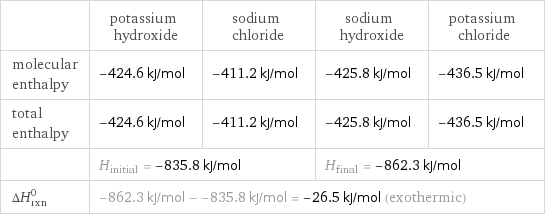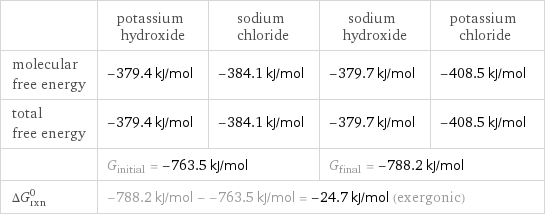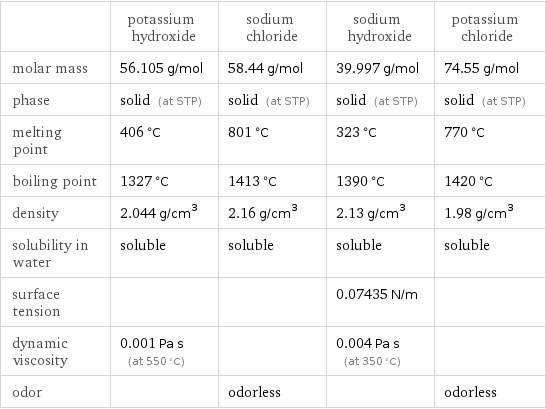Input interpretation

KOH potassium hydroxide + NaCl sodium chloride ⟶ NaOH sodium hydroxide + KCl potassium chloride
Balanced equation

Balance the chemical equation algebraically: KOH + NaCl ⟶ NaOH + KCl Add stoichiometric coefficients, c_i, to the reactants and products: c_1 KOH + c_2 NaCl ⟶ c_3 NaOH + c_4 KCl Set the number of atoms in the reactants equal to the number of atoms in the products for H, K, O, Cl and Na: H: | c_1 = c_3 K: | c_1 = c_4 O: | c_1 = c_3 Cl: | c_2 = c_4 Na: | c_2 = c_3 Since the coefficients are relative quantities and underdetermined, choose a coefficient to set arbitrarily. To keep the coefficients small, the arbitrary value is ordinarily one. For instance, set c_1 = 1 and solve the system of equations for the remaining coefficients: c_1 = 1 c_2 = 1 c_3 = 1 c_4 = 1 Substitute the coefficients into the chemical reaction to obtain the balanced equation: Answer: | | KOH + NaCl ⟶ NaOH + KCl
Structures

+ ⟶ +
Names

potassium hydroxide + sodium chloride ⟶ sodium hydroxide + potassium chloride
Reaction thermodynamics
Enthalpy

| potassium hydroxide | sodium chloride | sodium hydroxide | potassium chloride molecular enthalpy | -424.6 kJ/mol | -411.2 kJ/mol | -425.8 kJ/mol | -436.5 kJ/mol total enthalpy | -424.6 kJ/mol | -411.2 kJ/mol | -425.8 kJ/mol | -436.5 kJ/mol | H_initial = -835.8 kJ/mol | | H_final = -862.3 kJ/mol | ΔH_rxn^0 | -862.3 kJ/mol - -835.8 kJ/mol = -26.5 kJ/mol (exothermic) | | |
Gibbs free energy

| potassium hydroxide | sodium chloride | sodium hydroxide | potassium chloride molecular free energy | -379.4 kJ/mol | -384.1 kJ/mol | -379.7 kJ/mol | -408.5 kJ/mol total free energy | -379.4 kJ/mol | -384.1 kJ/mol | -379.7 kJ/mol | -408.5 kJ/mol | G_initial = -763.5 kJ/mol | | G_final = -788.2 kJ/mol | ΔG_rxn^0 | -788.2 kJ/mol - -763.5 kJ/mol = -24.7 kJ/mol (exergonic) | | |
Entropy

| potassium hydroxide | sodium chloride | sodium hydroxide | potassium chloride molecular entropy | 79 J/(mol K) | 72 J/(mol K) | 64 J/(mol K) | 83 J/(mol K) total entropy | 79 J/(mol K) | 72 J/(mol K) | 64 J/(mol K) | 83 J/(mol K) | S_initial = 151 J/(mol K) | | S_final = 147 J/(mol K) | ΔS_rxn^0 | 147 J/(mol K) - 151 J/(mol K) = -4 J/(mol K) (exoentropic) | | |
Equilibrium constant
![Construct the equilibrium constant, K, expression for: KOH + NaCl ⟶ NaOH + KCl Plan: • Balance the chemical equation. • Determine the stoichiometric numbers. • Assemble the activity expression for each chemical species. • Use the activity expressions to build the equilibrium constant expression. Write the balanced chemical equation: KOH + NaCl ⟶ NaOH + KCl Assign stoichiometric numbers, ν_i, using the stoichiometric coefficients, c_i, from the balanced chemical equation in the following manner: ν_i = -c_i for reactants and ν_i = c_i for products: chemical species | c_i | ν_i KOH | 1 | -1 NaCl | 1 | -1 NaOH | 1 | 1 KCl | 1 | 1 Assemble the activity expressions accounting for the state of matter and ν_i: chemical species | c_i | ν_i | activity expression KOH | 1 | -1 | ([KOH])^(-1) NaCl | 1 | -1 | ([NaCl])^(-1) NaOH | 1 | 1 | [NaOH] KCl | 1 | 1 | [KCl] The equilibrium constant symbol in the concentration basis is: K_c Mulitply the activity expressions to arrive at the K_c expression: Answer: | | K_c = ([KOH])^(-1) ([NaCl])^(-1) [NaOH] [KCl] = ([NaOH] [KCl])/([KOH] [NaCl])](../image_source/c4f443c966a344d43cc976df739137e8.png)
Construct the equilibrium constant, K, expression for: KOH + NaCl ⟶ NaOH + KCl Plan: • Balance the chemical equation. • Determine the stoichiometric numbers. • Assemble the activity expression for each chemical species. • Use the activity expressions to build the equilibrium constant expression. Write the balanced chemical equation: KOH + NaCl ⟶ NaOH + KCl Assign stoichiometric numbers, ν_i, using the stoichiometric coefficients, c_i, from the balanced chemical equation in the following manner: ν_i = -c_i for reactants and ν_i = c_i for products: chemical species | c_i | ν_i KOH | 1 | -1 NaCl | 1 | -1 NaOH | 1 | 1 KCl | 1 | 1 Assemble the activity expressions accounting for the state of matter and ν_i: chemical species | c_i | ν_i | activity expression KOH | 1 | -1 | ([KOH])^(-1) NaCl | 1 | -1 | ([NaCl])^(-1) NaOH | 1 | 1 | [NaOH] KCl | 1 | 1 | [KCl] The equilibrium constant symbol in the concentration basis is: K_c Mulitply the activity expressions to arrive at the K_c expression: Answer: | | K_c = ([KOH])^(-1) ([NaCl])^(-1) [NaOH] [KCl] = ([NaOH] [KCl])/([KOH] [NaCl])
Rate of reaction
![Construct the rate of reaction expression for: KOH + NaCl ⟶ NaOH + KCl Plan: • Balance the chemical equation. • Determine the stoichiometric numbers. • Assemble the rate term for each chemical species. • Write the rate of reaction expression. Write the balanced chemical equation: KOH + NaCl ⟶ NaOH + KCl Assign stoichiometric numbers, ν_i, using the stoichiometric coefficients, c_i, from the balanced chemical equation in the following manner: ν_i = -c_i for reactants and ν_i = c_i for products: chemical species | c_i | ν_i KOH | 1 | -1 NaCl | 1 | -1 NaOH | 1 | 1 KCl | 1 | 1 The rate term for each chemical species, B_i, is 1/ν_i(Δ[B_i])/(Δt) where [B_i] is the amount concentration and t is time: chemical species | c_i | ν_i | rate term KOH | 1 | -1 | -(Δ[KOH])/(Δt) NaCl | 1 | -1 | -(Δ[NaCl])/(Δt) NaOH | 1 | 1 | (Δ[NaOH])/(Δt) KCl | 1 | 1 | (Δ[KCl])/(Δt) (for infinitesimal rate of change, replace Δ with d) Set the rate terms equal to each other to arrive at the rate expression: Answer: | | rate = -(Δ[KOH])/(Δt) = -(Δ[NaCl])/(Δt) = (Δ[NaOH])/(Δt) = (Δ[KCl])/(Δt) (assuming constant volume and no accumulation of intermediates or side products)](../image_source/39819ab32446912bc2bfb5bf1cbf1c5b.png)
Construct the rate of reaction expression for: KOH + NaCl ⟶ NaOH + KCl Plan: • Balance the chemical equation. • Determine the stoichiometric numbers. • Assemble the rate term for each chemical species. • Write the rate of reaction expression. Write the balanced chemical equation: KOH + NaCl ⟶ NaOH + KCl Assign stoichiometric numbers, ν_i, using the stoichiometric coefficients, c_i, from the balanced chemical equation in the following manner: ν_i = -c_i for reactants and ν_i = c_i for products: chemical species | c_i | ν_i KOH | 1 | -1 NaCl | 1 | -1 NaOH | 1 | 1 KCl | 1 | 1 The rate term for each chemical species, B_i, is 1/ν_i(Δ[B_i])/(Δt) where [B_i] is the amount concentration and t is time: chemical species | c_i | ν_i | rate term KOH | 1 | -1 | -(Δ[KOH])/(Δt) NaCl | 1 | -1 | -(Δ[NaCl])/(Δt) NaOH | 1 | 1 | (Δ[NaOH])/(Δt) KCl | 1 | 1 | (Δ[KCl])/(Δt) (for infinitesimal rate of change, replace Δ with d) Set the rate terms equal to each other to arrive at the rate expression: Answer: | | rate = -(Δ[KOH])/(Δt) = -(Δ[NaCl])/(Δt) = (Δ[NaOH])/(Δt) = (Δ[KCl])/(Δt) (assuming constant volume and no accumulation of intermediates or side products)
Chemical names and formulas

| potassium hydroxide | sodium chloride | sodium hydroxide | potassium chloride formula | KOH | NaCl | NaOH | KCl Hill formula | HKO | ClNa | HNaO | ClK name | potassium hydroxide | sodium chloride | sodium hydroxide | potassium chloride
Substance properties

| potassium hydroxide | sodium chloride | sodium hydroxide | potassium chloride molar mass | 56.105 g/mol | 58.44 g/mol | 39.997 g/mol | 74.55 g/mol phase | solid (at STP) | solid (at STP) | solid (at STP) | solid (at STP) melting point | 406 °C | 801 °C | 323 °C | 770 °C boiling point | 1327 °C | 1413 °C | 1390 °C | 1420 °C density | 2.044 g/cm^3 | 2.16 g/cm^3 | 2.13 g/cm^3 | 1.98 g/cm^3 solubility in water | soluble | soluble | soluble | soluble surface tension | | | 0.07435 N/m | dynamic viscosity | 0.001 Pa s (at 550 °C) | | 0.004 Pa s (at 350 °C) | odor | | odorless | | odorless
Units
